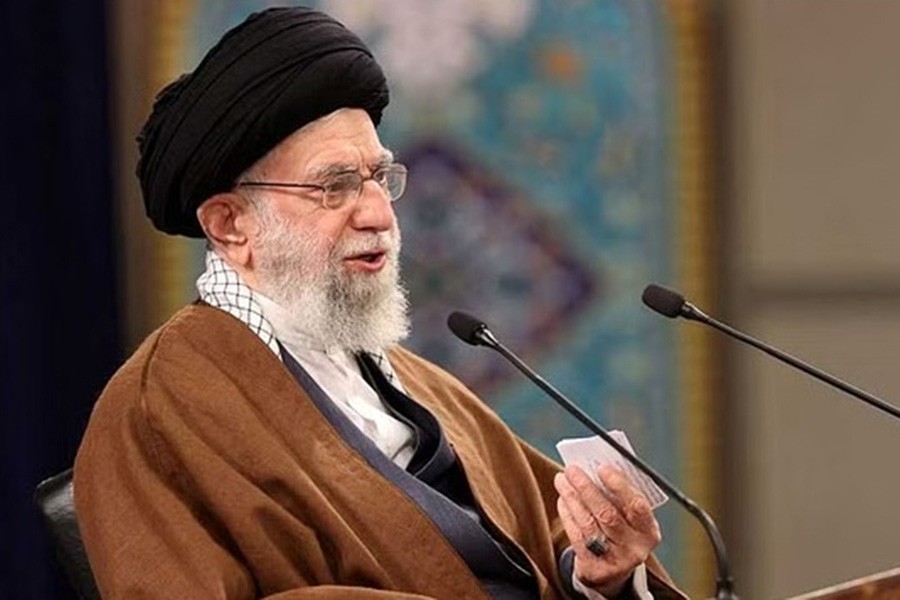Iran's clerical rulers are eager to crush mass anti-government protests, but manoeuvring over the eventual succession to the supreme leader and rifts over security tactics have complicated efforts to curb the unrest, three analysts and an official said.
The ever bolder protests, sparked by the death of a woman in police custody, have put Iran's leaders on the defensive, with officials apparently unable to close ranks behind an agreed response to the turmoil, the analysts and the official said.
Challenging the legitimacy of Iran's top authority, protesters have this month burned pictures of Ayatollah Ali Khamenei, called for the downfall of the Islamic Republic and chanted "Death to the Dictator", unfazed by security forces using tear gas, clubs and, in some cases, live ammunition.
The unrest poses a grave threat to the priority that has defined Khamenei's rule -- the survival of the four-decade-old Islamic Republic and its religious establishment, at any cost, reports Reuters.
But the fact that the unrest coincided with rumours about his ailing health -- he is 83 -- has only made matters worse, since the faction-ridden elite has been preoccupied with his eventual succession, the analysts and official said.
Although in theory an 86-member body known as the Assembly of Experts will choose the next leader, high level negotiations and jockeying for influence have already begun, making it difficult for the establishment to unite around a set of security tactics.
"This race has caused disarray inside the leadership. The deepening rift is the last thing we need when the country is in turmoil," said a hardline official.
"The main issue right now is the Islamic Republic's survival."
Khamenei himself has been silent about the protests, which quickly grew into a revolt against what protesters said was the increasing authoritarianism of the ruling clerics.
The two names that come up most often in speculation about the succession are President Ebrahim Raisi and Khamenei's second son Mojtaba, said Karim Sadjadpour, a senior fellow at the Carnegie Endowment for International Peace.
"Neither of them has popular support, but what keeps the Islamic Republic in power is not popular support, but repression. Both men are deeply experienced in repression," he said.
TOUGHER MEASURES
Brazen protesters have directed anger at Mojtaba Khamenei, risking the wrath of his all-powerful father.
"Mojtaba, may you die and not become Supreme Leader," could be heard in videos from protests on Twitter.
Alarmed by the depth of popular discontent and outrage, some senior clerics and politicians have appealed for restraint to avoid bloodshed that could galvanise and embolden protesters.
But that has not stopped hardliners calling for tougher measures.
"A part of the establishment fears that this time using more lethal force can push the Islamic Republic to a no return point," said a senior former Iranian official.
However, top authorities like hardliner Raisi have said that the protests "would not lead to regime change".
Videos on social media show Iran's security forces struggling to end the protests, which were triggered by the death of 22-year-old Mahsa Amini's death on Sept. 13. She had been arrested for "unsuitable attire" by the morality police who enforce the Islamic Republic's strict dress code.
Reuters could not verify the videos.
Demonstrations have spread from Amini's Kurdish hometown of Saqez to all of Iran's 31 provinces, with all layers of society, including ethnic and religious minorities, joining in.
Fearing an ethnic uprising and in a show of power, Iran fired missiles and drones at targets in neighbouring northern Iraq's Kurdish region after accusing Iranian Kurdish dissidents of being involved in the unrest.
Rights groups say Kurds and other religious and ethnic minorities face discrimination under the clerical establishment.
A collapse of the Islamic Republic may seem remote in the near term, since its leaders are determined not to show the kind of weakness they believe sealed the fate of the US-backed Shah in 1979, a senior Iranian official told Reuters.
'ATTRITION REPRESSION'
But unrestrained repression seems off the menu, for now.
An Assistant Professor of political science at the University of Tennessee at Chattanooga, Saeid Golkar said "further delegitimisation of the regime" could be behind the establishment's decision to choose "attrition repression instead of the 2019 iron fist strategy".
Protests over fuel prices rising in 2019 - when Reuters reported 1,500 people were killed - were the bloodiest confrontation in the Islamic Republic's history.
Iranian state media said 41 people, including members of security forces, died during the unrest. Amnesty International said on Friday "the crackdown has left at least 52 identified victims dead and hundreds injured to date". Thousands have been arrested, according to rights groups.
International support for the protests has made it harder for the authorities to crack down, especially as there are no apparent protest leaders who can be identified and rounded up.
Iran’s rulers have accused a coalition of “anarchists, terrorists and foreign foes" of orchestrating the troubles -- a narrative few Iranians believe.
"Iran’s leaders are probably trying to see if a combination of internet shutdowns, mass arrests, and some violence against protesters will slow the momentum of the protests," said Eurasia Group analyst Henry Rome.
"But I don’t think anyone should doubt that, at the end of the day, the state has a backstop of loyal enforcers willing to kill their fellow citizens who can be called upon to end this round of protests."


